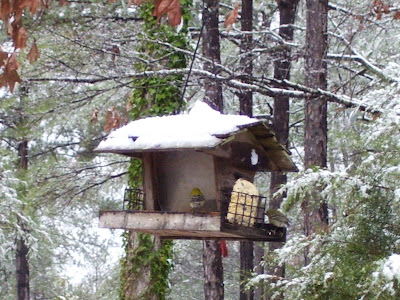Attracting wildlife to the garden is a goal for many gardeners. Few things are more relaxing than sitting in a quiet spot, viewing birds flitting around among the plants, locating food, bathing, and dancing around in an attempt to attract a mate.
As gardeners, we look for plants that will bring butterflies to our garden, hummingbirds to our window, and birds to our feeders.
Attracting wildlife to your garden is very simple--birds and butterflies just need a few things to make them happy! When searching for a place to live, animals look for water and food sources, shrubs and brush for safety from predators, and safe places to build nests for raising young.
To attract wildlife into your garden, you must provide what the animals need for survival:
- Food
- Water
- Shelter from predators
- Safe place to nest and raise young
Water sources are easy to provide. Birdbaths are widely available in garden centers, home improvement stores, discount stores, and even craft and hobby stores. Birdbaths are also easy to make using items found at flea markets and yard sales or purchased terracotta plant saucers. Birds prefer a shallow bowl rather than a deep one. Just remember to place it near a good spot for shelter if the bird needs it, but not too close to a tree or shrub that would provide good hiding spots for predators like cats. Remember to keep the water bowl clean and filled with fresh clean water.
Food and Nesting Sites can also be easily provided. One of the most important things you can do to bring wildlife into your garden is to plant native plants! By doing this, you will provide what birds and butterflies need most: food and shelter. Butterflies will drink nectar from any suitable flower, but each species of butterfly depends on just certain plants for host plants on which to lay their eggs. Some examples are: Milkweed, Asclepias (Commonly known as Butterfly Weed), Dill, Fennel, and Parsley. In fact, herbs attract a number of butterflies and other beneficial insects like ladybugs.
In addition to providing food and shelter for wildlife, when you plant native plants, you’ll be planting plants that will thrive in your climate, thus making gardening with native plants easier than gardening with foreign exotic species.
One other thing to consider when planting foreign species is that many of these exotic plants simply take over and crowd out native plants that are necessary for the survival of our wildlife. Think of how kudzu and privet have taken over in the southeast! One simply has to travel a little way down any highway in Georgia or Alabama to see how these plants have crowded out everything else. When crowding out native plants, they crowd out some of the wildlife species that depend on certain plants for survival.
And what could be more beautiful than a native azalea in full bloom? Nothing smells sweeter than the banana-pineapple scented blooms of our native sweetshrub. Our American native honeysuckle vine with its bright red blooms will attract whole families of hummingbirds, yet won’t take over and pop up all over the community as does the very aggressive Japanese honeysuckle.
I hope you'll visit again for more plant recommendations to attract birds and butterflies into your garden. In the meantime, drop by our Shady Gardens Nursery online store to see if we have some of the plants you need for your wildlife garden.





